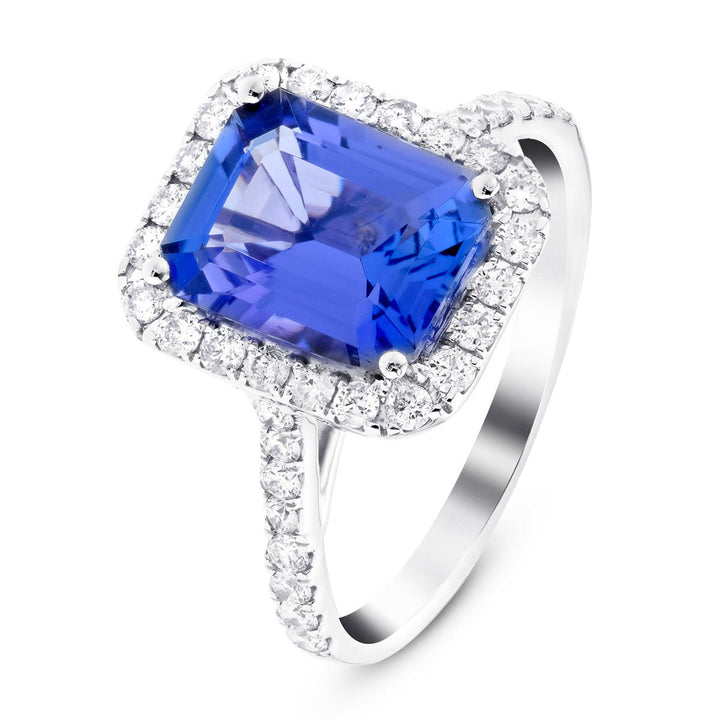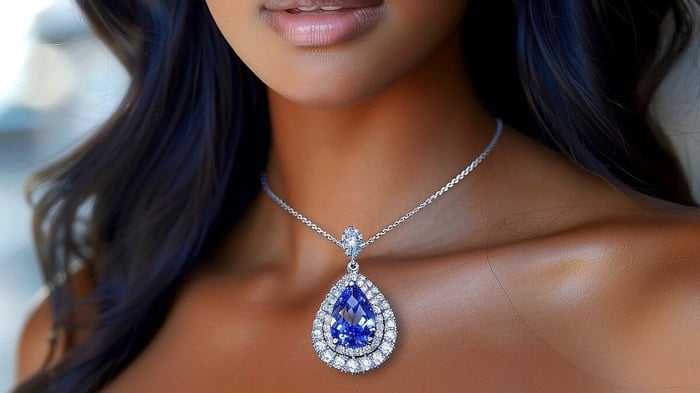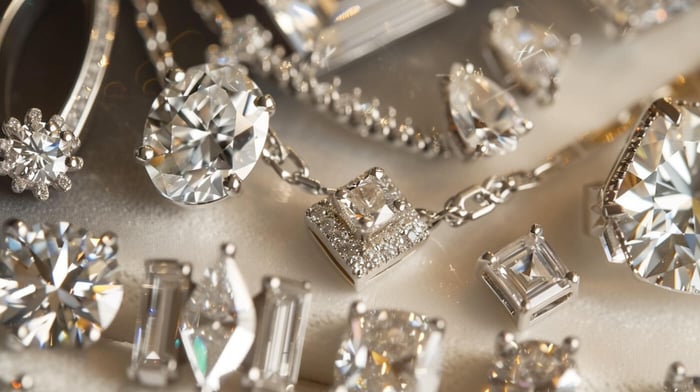Quick Answer
Deep blue tanzanite is unique due to its stunning blue-to-violet pleochroism, which heat treatment enhances. It is found only in Tanzania, making it rare and highly valued.
Tanzanite, a gemstone renowned for its captivating blue to violet hues, exudes exclusivity and elegance. Found exclusively in Tanzania, its rarity is enhanced through precise heat treatments that reveal its trichroic properties.
The finest specimens display a violet-blue colour with excellent clarity and minimal inclusions, often cut into shapes like oval and cushion to maximize brilliance. Tanzanite's pleochroism adds a unique complexity, showing different colours from various angles.
Favoured for high-end jewellery, its value and allure are amplified by its scarcity and exceptional qualities. Discover what makes this gemstone genuinely extraordinary.
Main Highlights About Blue Tanzanite
• Tanzanite's trichroic nature and heat treatments result in its stunning blue-to-violet hues.
• Found only in a unique geological formation in Tanzania, tanzanite is remarkably rare and highly prized.
• The ideal tanzanite exhibits a slightly violet-blue hue, minimal colour zoning, and a preferred tone between 75-85%.
• Its pleochroism adds complexity and beauty, displaying different colours based on the crystal axis.
• Larger dark blue tanzanite stones, particularly those above 50 carats, are exceedingly rare and highly valued.
£2,027.00
This simple yet elegant necklace is a must-have fashion jewellery piece for any occasion. A diamond necklace with a simple design, it's a refined and timeless accessory that is a wonderful choice for any occasion. A unique and elegant design,… read moreTanzanite 1.20ct & 1.00ct G/SI Diamond Necklace in 18k White Gold

£3,587.00
Why is Tanzanite Special?
Understanding what makes tanzanite special begins with appreciating its unique colour properties, which stem from its trichroic nature and the heat treatments it undergoes to achieve its prized blue-to-violet hues. This exceptional gemstone originates from a singular geological formation at the foothills of Mt. Kilimanjaro in Tanzania, making it exceedingly rare. Its rarity and meticulous heating required to reveal its vibrant colours ensure tanzanite's esteemed position in the gemological world.
Discovered in 1967, tanzanite has rapidly gained significant value and cultural importance. Often set in high-end jewellery, it symbolizes luxury and sophistication, establishing itself as a modern emblem of status and elegance. Tanzanite is now recognised as the birthstone for December.
The appreciation of tanzanite also necessitates consideration of ethical sourcing and sustainability. The Tanzanian government has implemented strict regulations on exporting rough material, ensuring the local population benefits economically from this precious resource. Ethical sourcing practices enhance the stone's desirability and contribute to sustainable development, preserving the environment and the livelihoods of those who mine this extraordinary gem.
Blue Tanzanite, Colour Considerations
When evaluating tanzanite, colour considerations are paramount due to the gem's vibrant hues that range from deep blues to purples, often enhanced through heat treatment. Colour grading significantly influences the gemstone's market trends and overall value.
The most sought-after tanzanites exhibit an intense, slightly violet-blue hue, imparting unique depth and warmth to the stone.
Colour zoning, where different colours appear in various gemstone areas, should be minimal in high-value tanzanites to ensure uniformity and enhance aesthetic appeal. Another critical aspect is colour intensity; gems with a tone between 75 and 85% are considered ideal, balancing rich colour with good transparency.
Moreover, tanzanite's ability to exhibit colour shifts—appearing blue in daylight and purple under artificial light—adds a fascinating dynamic to its allure. This characteristic can influence consumer preferences and market trends.
High-quality blue tanzanite crystals that maintain their vibrancy regardless of lighting conditions are immensely prized, highlighting the importance of meticulous colour evaluation in determining gemstone value.
£1,677.00
Presenting our exquisite 3.60ct Tanzanite & Diamond Oval Cluster Earrings, beautifully set in 18k white gold. Each earring showcases a mesmerizing oval tanzanite surrounded by sparkling diamonds, highlighting the luxurious craftsmanship. The earrings feature 0.95ct of natural, oval-cut tanzanite and… read more3.60ct Tanzanite & Diamond Oval Cluster Earrings 18k White Gold

£2,507.00
Tanzanite’s Pleochroism
When light passes through a crystal in a specific direction, the crystal structure absorbs a particular wavelength, giving rise to the phenomenon known as pléochroism, which causes a crystal to display several colours. Tanzanite is one of the crystals that exhibit this phenomenon.
Depending on the crystal axis viewed, pleochroism in tanzanite reveals a captivating array of colours, including blue, red, purple, green-yellow, and brown. This optical phenomenon is inherent to the gemstone's crystal structure, causing light to split into multiple wavelengths and creating a vivid display of colours that change dramatically with the viewing angle.
In gemology, pleochroism in tanzanite is an aesthetic feature and a crucial factor in gem cutting. Skilled lapidaries must decide whether to prioritize weight retention or the most desirable colour presentation. This decision is particularly challenging given the stone's tendency to exhibit different hues along different axes. The most sought-after tanzanites display a deep blue hue. Still, the cutting process often enhances the gem's purple tones, adding to its allure.
The colour change in tanzanite is especially striking under different lighting conditions, often appearing more violet under artificial light. This dynamic interplay of hues underscores tanzanite's exceptional beauty and complexity, making it a gemstone that continues to captivate collectors and gemologists.
£1,557.00
Tanzanite is one of the rarest gems. Its deep, rich shade of purple and blue hues makes it eye-catching and unique. Add these stones to your ring and make a statement. The oval shape gives the ring a certain elegance,… read moreHalo Oval Tanzanite 1.85ct and Diamond 0.41ct Ring in 18K White Gold

£2,597.00
Tanzanite’s Clarity and Quality
Tanzanite is highly esteemed for its mesmerizing pleochroism and its exceptional clarity and overall quality. Typically, tanzanite exhibits very high clarity with minimal inclusions, enhancing its visual appeal and value. When inclusions are present, they are often needle-like and can produce the rare and desirable cat's eye effect. This high clarity is achieved through a meticulous process where faceters remove fractures and inclusions before the stones undergo heat treatment, ensuring top-notch quality.
The origin myths surrounding tanzanite add to its allure. One popular tale attributes its discovery to Maasai herders who found the stunning blue stones after a lightning strike ignited a wildfire. This exotic narrative boosts the gemstone's desirability and influences its market perception and pricing. Tanzanite's clarity and quality significantly impact its price, with clearer stones commanding higher premiums.
Famous wearers of tanzanite include Elizabeth Taylor and Beyoncé, whose endorsements have elevated the gemstone's stature in high fashion. These endorsements reinforce tanzanite's reputation as a gemstone of unparalleled elegance, sought after by discerning collectors and jewellery enthusiasts alike.
Choose the Right Cut For Your Tanzanite Crystal
Selecting the best cut for tanzanite involves balancing the stone's natural beauty with its inherent rarity. Given tanzanite's unique pleochroism and vivid hues, the choice of cut profoundly influences its visual appeal. Faceting techniques are crucial for enhancing the stone's colour and brilliance.
Lapidaries often prefer deeper cuts to amplify tanzanite's rich tones, with oval and cushion cuts being particularly favoured due to their ability to retain significant weight while showcasing the gem's vibrant spectrum.
Custom designs can further enhance the allure of tanzanite, allowing for bespoke creations that highlight the stone's exceptional qualities. The lapidary's expertise in selecting the appropriate angle and depth for each facet ensures the gem's natural beauty is fully realized. It is not uncommon for tanzanite to undergo a recut after heat treatment to further refine its clarity and colour.
Lapidary preferences are pivotal in determining the final appearance of the gemstone. The decision to prioritize colour over weight, or vice versa, depends mainly on the intended use and personal tastes. Ultimately, the optimal cut for tanzanite blends artistry with precision, yielding a stunning and rare gem.
£1,677.00
Add Description… read more3.60ct Tanzanite & Diamond Oval Cluster Earrings 18k Rose Gold

£2,507.00
Carat and Size of Tanzanite is Important
Understanding the carat and size of tanzanite is crucial for assessing its quality and value. Carat weight significantly impacts the pricing of tanzanite, with smaller gems under 2 carats often lacking the desirable vivid hues. In contrast, stones exceeding 5 carats are more likely to exhibit top colours, leading to a marked increase in their average price per carat. This pricing structure highlights the rarity and limited availability of high-quality tanzanite in smaller sizes, making larger specimens particularly sought after.
The scarcity of tanzanite above 50 carats further enhances its exclusivity and value. As the gemstone's size increases, so does its value, primarily due to better colour saturation and greater aesthetic appeal. Collectors and connoisseurs often pursue these larger stones, valuing their unique characteristics and the rarity of finding such specimens in excellent condition.
Blue Tanzanite for Jewellery and Investment
C:\Users\andrew\OneDrive\Desktop\zimmwriter\output\Tanzanite_the_Beautiful_Blue_Gemstone_0001.jpg
When considering tanzanite for jewellery, it's essential to account for its hardness and brittleness, as these factors influence its suitability for various adornments. With a hardness rating of 6.5 on the Mohs scale, tanzanite is best suited for occasional wear or pieces less prone to damage, such as earrings, necklaces, and pendants. Protective settings are essential to prevent chipping and scratching for rings.
Regarding market trends, tanzanite has experienced significant volatility since its discovery in 1967. Factors such as political stability in Tanzania, where the only known deposits exist, have contributed to fluctuations in supply and, consequently, price. Investors must carefully weigh these risks and rewards.
The rarity of tanzanite and the potential discovery of new gem-grade zoisite deposits that can undergo heat treatment to produce similar hues have an impact on its long-term value. Such discoveries could impact market stability, but the allure of tanzanite's unique colour and pleochroism continues to attract collectors and connoisseurs.
Despite the inherent risks, investing in tanzanite can be rewarding because it is a highly coveted and visually striking gemstone.
£397.00
This is a gorgeous tanzanite and diamond cluster ring that anyone would be proud to wear. Our British designers have used UK hallmarked 9k white gold as a backdrop to the brilliant blue tanzanite centre stone weighing 0.50 carat and… read moreTanzanite 0.50ct Diamond 0.04ct Cluster Ring 9k White Gold

£527.00
Tanzanite Pricing
Having covered all the elements that create value and price, let's now consider that last item, how much tanzanite costs. Because of its rarity, tanzanite still costs significantly less than natural diamond. Combined with its beauty, it is something of a bargain. The prices in the table below are illustrative. Still, they will vary depending on where in the supply chain you purchase between mine and the retail jeweller.
Tanzanite Per Carat Prices in 2024
(assuming good cutting, proportions and VVS clarity)
Carat Weight | Finest 1% Mined | AAA Grade | AA Grade | A Grade | B Grade |
0.00 - 1.99 carats | £480 - £560 | £340 - £384 | £240 | £160 | £80 |
2.00 - 2.99 carats | £600 - £1080 | £400 - £440 | £260 | £200 | £120 |
3.00 to 9.99 carats | £624 - £1104 | £440 - £460 | £280 | £220 | £136 |
10 carats plus | £640 - £1200 | £464 - £472 | £320 | £240 | £152 |
Given the inevitability of tanzanite becoming mined out, we can expect that prices will increase steeply as we move to that point and that good, large tanzanite crystals will become very valuable when there are no more to be taken from the ground!
£777.00
You're looking for a ring to make a statement, or you just want to feel like a million bucks, this is the perfect choice for you! The tanzanite and diamond halo ring is made with the best materials and will… read moreHalo Oval Tanzanite 0.47ct and Diamond 0.27ct Ring in Platinum

£1,307.00
Tanzanite Treatments For Improvement
Most tanzanite gemstones undergo a relatively low-temperature heat treatment (500-600°C) to achieve their vibrant hues. This heat treatment is crucial in transforming the gem's natural brownish tones into the striking blue and violet shades that have captivated collectors and connoisseurs. While most tanzanite on the market has been treated, the certification process ensures transparency and authenticity.
Sometimes, tanzanite specimens receive chemical coatings to enhance their colour and lustre. These coatings, identifiable through meticulous analysis, often contain cobalt, zinc, antimony, and lead. However, buyers should know that such enhancements may diminish over the course of years and wear, revealing the gem's original nature.
In 2012, rumours surfaced about dye-treated tanzanite, suggesting that some zoisite had been infused with purple dye to mimic natural tanzanite. These rumours have been thoroughly debunked, with gemological laboratories confirming that the suspect specimens were not dyed. Instead, the peculiar colouring observed was attributed to the stone's inherent pleochroism, a natural optical phenomenon discussed above.
Ultimately, the allure of tanzanite lies in its breathtaking beauty and meticulous processes that guarantee its quality and authenticity.
Tanzanite Simulants and Synthetics

Various materials are used as simulants for tanzanite, each identifiable through specific gemological tests. Recognizing these imitations is crucial for preserving the integrity and value of this prized gemstone. Notable simulants include synthetic forsterite, synthetic yttrium aluminium garnet (YAG), synthetic sapphire, and different types of glass.
Synthetic forsterite, known for its birefringent properties, displays doubled-back facets when viewed through the gem table. Its lower refractive index and green appearance under a Hanneman filter further distinguish it from natural tanzanite. Synthetic YAG, marketed as Tanavyte®, is a compelling alternative due to its superior hardness of 9 and distinct orange fluorescence under ultraviolet light. Its refractive index of 1.8 also sets it apart from natural tanzanite.
Synthetic sapphire, also called Coranite, is another significant simulant. Despite its visual similarity to tanzanite, it shows a grey-green hue under a Hanneman filter, making identification easier.
Glass alternatives, including blue or purple glass and colour-change glass, offer budget-friendly options but lack genuine tanzanite's durability and distinct optical properties.
Proper gemological testing is essential for ensuring the authenticity and value of tanzanite in the market.
£2,607.00
Say hello to one of the most dazzling rings you'll ever see! Crafted with tanzanite and diamonds, this ring is a sight to behold. The 4.86 carat tanzanite stone is a natural occurring gemstone that is known for its deep,… read moreHalo Tanzanite 4.86ct and Diamond 0.53ct Ring in Platinum

£4,597.00
You'll Love Tanzanite as Much as We Do!
Like a diamond, tanzanite's true beauty is revealed through careful selection and knowledgeable appreciation, affirming its status as a gemstone of unparalleled charm and value.
When you see blue tanzanite, I believe you will be in awe of its colour and how it changes as the light falling on the gemstone changes.
Tanzanite is fascinating to look at. When you wear a tanzanite ring, you will probably find yourself looking at the ring on your finger! Add the sparkle of natural diamonds, and you will have a piece of jewellery that will be a showstopper!
Tanzanite, renowned for its captivating hues and exceptional pleochroism, exemplifies nature's artistry.
This gemstone, found exclusively in Tanzania, intrigues with its stable colour and versatile appeal.
To make an informed purchase, you should be able to appreciate tanzanite's colour, clarity, cut, and carat weight and considerations for its care and investment potential. If all those look as good to you as the beautiful gemstones themselves, then you need to check out our collections of jewellery incorporating tanzanite. We have beautiful tanzanite and diamond rings. Deep blue earrings withice-white diamond halos. You’ll fall in love with our tanzanite and diamond necklaces and pendants.
Every piece of jewellery we sell is designed and handcrafted in the United Kingdom for great design sense and world-beating workmanship. We stand behind our artisans’ artistry with a lifetime workmanship guarantee. And, because there’s nothing better than seeing the piece you dreamed of in your own home, we even offer a 30-day return and exchange program! Any one of our tanzanite and diamond jewellery pieces will be a perfect addition to the right jewellery collection and impress on every occasion it is worn!
Frequently Asked Questions
How Should I Care for My Tanzanite Jewellery?
To care for your tanzanite jewellery, avoid ultrasonic cleaners and harsh cleaning solutions; use mild soap and lukewarm water for cleaning. Due to its moderate scratch resistance, store tanzanite pieces separately to prevent abrasions.
Can Tanzanite Be Used in Engagement Rings?
Deep blue tanzanite has a vibrant allure, making it a captivating choice for engagement rings. However, its relative softness and susceptibility to scratching and chipping raise durability concerns. Despite these issues, its unique beauty and rarity continue to attract discerning buyers.
Is Tanzanite a Good Option for Daily Wear?
Tanzanite is not recommended for daily wear due to its moderate scratch resistance and potential for colour fading when exposed to prolonged sunlight. For occasional use, protective settings in jewellery are advised to maintain its appearance and durability.
What Are the Most Popular Settings for Tanzanite Rings?
Popular settings for tanzanite rings include vintage designs, custom settings, and halo rings. These choices enhance the gem's vivid hues and appeal to those looking for timeless elegance and bespoke craftsmanship.
How Should I Store My Tanzanite to Prevent Damage?
To prevent damage to your tanzanite, store it at a stable temperature, ensure controlled humidity levels, and wrap the gemstone in a soft cloth. This approach protects it from scratches and environmental factors, maintaining its quality and longevity.



